Presonus StudioLive 32.4.2 AI Owner’s Manual
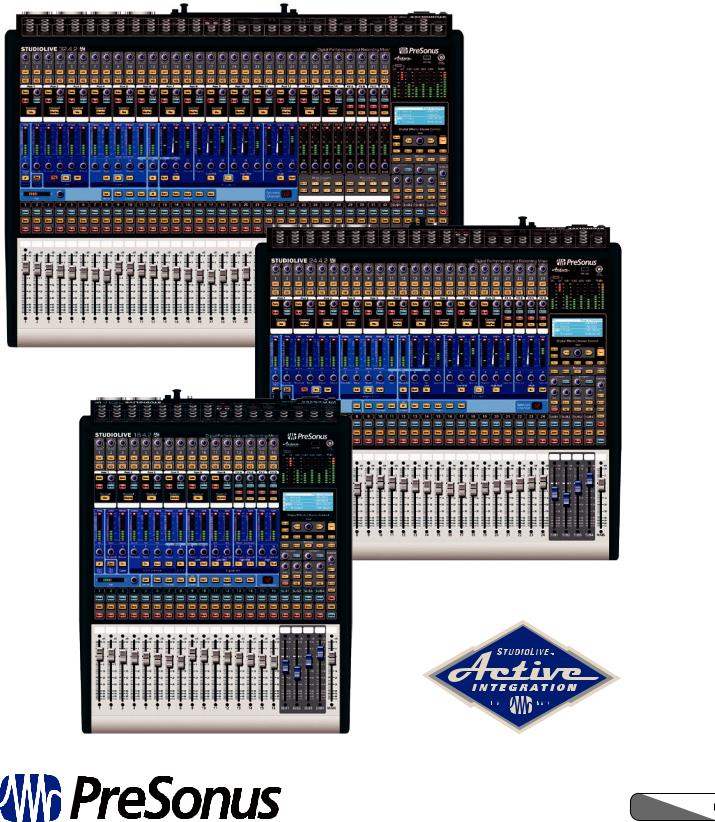
StudioLive™ AI-Series Mixers
Digital Mixing System with Active Integration™
Owner’s Manual
®
www.presonus.com
English
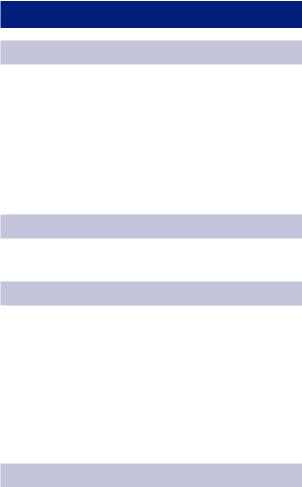
Table of Contents
1Overview — 1
1.1Introduction — 1
1.2About This Manual — 2
1.3Summary of StudioLive AI-series Mixer Hardware Features — 2
1.4What is in the Box — 3
2Getting Started — 4
2.1Level Setting Procedure — 4
3Hookup — 9
3.1Rear-Panel Connections — 9
3.1.1Installed Option Card — 13
3.2Front Panel Connections — 13
3.3Typical Band Setup Diagrams — 14
3.4Typical Church Setup Diagrams — 16
4Controls — 18
4.1The Fat Channel — 18
4.1.1Select Buttons, Meters,
and the Fat Channel — 18
4.1.2Fat Channel Processing Guide — 19
4.1.3Fat Channel: Dynamics Processing and EQ — 19
4.1.4Sidechaining (32.4.2AI
and 24.4.2AI only) — 27
4.1.5A/B Fat Channel Settings — 28
4.1.6Fat Channel Panning, Stereo Link, and Link Master — 29
4.1.7Fat Channel: Subgroup
and Main Output Assignments — 29
4.1.8Copying Fat Channel Settings — 30
4.1.9Loading Fat Channel Presets — 31
4.1.10Saving Fat Channel Presets — 32
4.1.11Channel Presets Library — 34
4.2Metering — 35
4.2.1StudioLive Fat Channel Metering Controls — 35
4.2.2Subgroup and Main Meters — 36
4.2.3A Quick Note About dBu and dBFS — 36
4.3Input Channel Strip — 37
4.3.1Input Channel Controls — 37
4.4Aux and FX Buses — 38
4.4.1Analog Aux Bus Controls — 38
4.4.2Internal FX Bus Controls — 39
4.4.3Aux and FX Bus Channel Sends — 39
4.4.4Pre/Post Channel Sends — 40
4.4.5Creating Monitor Mixes — 40
4.4.6Creating Internal FX Mixes — 41
4.4.7Using an External Effects Processor — 43
4.5Subgroups — 45
4.5.1Subgroup Controls — 45
4.5.2Creating Instrument Subgroups — 46
4.5.3Creating Effects Groups — 47
4.6Main Output Bus — 49
4.7Mute Groups (StudioLive 32.4.2AI only) — 50
4.7.1Creating a Mute Group
(StudioLive 32.4.2AI only) — 51
4.8Master Section — 51
4.8.1Aux Inputs A and B — 51
4.8.2Talkback System — 52
4.8.32 Track In — 52
4.9Solo Bus — 53
4.9.1Solo Bus Controls — 53
4.9.2Solo Modes — 54
4.9.3Solo Clear — 54
4.9.4Using the Solo Bus for Monitoring — 54
4.9.5Using Solo in Place (SIP) to Set Up a Mix — 55
4.10Monitor Bus — 57

5 Digital Effects
| Master Control — 59
5.1Channel Info Page — 59
5.1.1Customizing Channel and Bus Names — 59
5.2The Digital FX (Effects) Menu — 60
5.2.1Creating FX Presets — 61
5.2.2Reverb and its Parameters — 63
5.2.3Delay and its Parameters — 64
5.2.4Reverb Effects Preset Library — 65
5.2.5Delay Effects Preset Library — 65
5.2.6Digital Effects Types — 66
5.3Scenes — 67
5.3.1S1: Zero Out (Board Reset) — 67
5.3.2Nulling Parameters — 68
5.3.3Creating a Scene — 68
5.3.4Scene Recall — 69
5.3.5Fader Locate — 71
5.3.6Quick Scenes
(StudioLive 32.4.2AI only) — 71
5.3.7AutoStore — 73
5.4Graphic Equalizers — 73
5.4.1The GEQ Menu — 74
5.4.2Saving and Loading Graphic EQ Presets — 75
5.5System Menu — 77
5.5.1 Firmware Updates — 80
6Resources — 85
6.1Stereo Microphone Placement — 85
6.2Compression Setting Suggestions — 88
6.3EQ Frequency Guides — 90
6.4EQ Setting Suggestions — 91
6.5Technical Specifications — 94
6.6StudioLive AI Mixers Block Diagrams — 97
6.7StudioLive 32.4.2AI Recall Sheet — 98
6.8StudioLive 24.4.2AI Recall Sheet — 100
6.9StudioLive 16.4.2AI Recall Sheet — 102
6.10StudioLive 16.4.2AI
Rack Ear Installation — 103
7Troubleshooting
and Warranty — 104
7.1Troubleshooting — 104
7.2PreSonus Limited Warranty — 105

iv
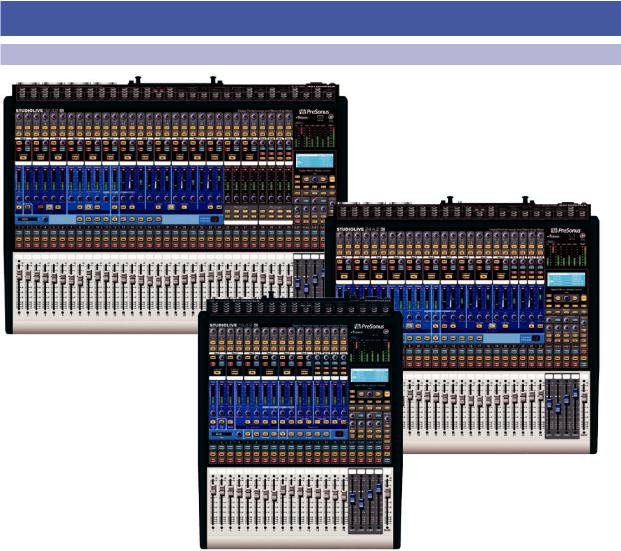
1 |
Overview |
StudioLive™ 32.4.2AI |
1.1 |
Introduction |
Owner’s Manual |
1Overview
1.1Introduction
Thank you for purchasing your PreSonus® StudioLive™ AI-series Performance and Recording Digital Mixer. PreSonus Audio Electronics has designed the StudioLive utilizing high-grade components to ensure optimum performance that will last a lifetime. Loaded with 32/24/16 high-headroom, XMAX™ microphone preamplifiers; a built-in 48x34/40x26/32x18 FireWire s800 recording and playback interface; Fat Channel processing with 4-band EQs, compressors, limiters, and expander/gates; reverb and delay effects; 14/10/6 aux buses; 4 subgroups; extensive LED metering; mixer save/recall; channel-strip save/recall/copy/paste; talkback; and more, StudioLive breaks new boundaries for music performance and production. All you need is a compatible computer with a FireWire connection, a few microphones and cables, speakers, and your instruments,
and you are ready to record in the studio or in front of a live audience!
We encourage you to contact us with questions or comments regarding this product. PreSonus Audio Electronics is committed to constant product improvement, and we value your suggestions highly. We believe the best way to achieve our goal of constant product improvement is by listening to the real experts: our valued customers. We appreciate the support you have shown us through the purchase of this product.
For technical support, please see Section 7.1: Troubleshooting.
1

1 |
Overview |
StudioLive™ 32.4.2AI |
1.2 |
About This Manual |
Owner’s Manual |
1.2 About This Manual
We suggest that you use this manual to familiarize yourself with the features, applications, and connection procedures for your StudioLive before trying to connect it to your computer. This will help you avoid problems during installation and setup. This manual covers hardware functions for all three StudioLive AI-series mixers. When functional differences are called out,
the 32.4.2AI will be mentioned first, followed by the 24.4.2AI and then the 16.4.2AI. Note: All illustrated examples use images of the 32.4.2AI.
A separate manual, also included with your StudioLive mixer, covers the StudioLive AI Software Library, as well as instructions for connecting and using your StudioLive with a computer.
Throughout this manual you will find Power User Tips. These tips provide mixing tricks, some of which are unique to the StudioLive, as well as explanations
of various audio terms. In addition, you will find an assortment of audio tutorials at the back of this manual. These tutorials cover everything from microphone placement to equalizer and compression-setting suggestions and are included to help you get the most from your StudioLive mixer.
Thank you, once again, for buying our product. We are confident that you will enjoy your StudioLive!
1.3Summary of StudioLive AI-series Mixer Hardware Features
•• 24-bit resolution, up to 48 kHz sampling rate
•• 32/24/16 Class A XMAX microphone preamplifiers with individual phantom power
•• 32/24/16 line-level inputs
•• 32/24/16 analog inserts
•• 32/24/16 direct outputs
•• 2 balanced stereo auxiliary inputs
•• Analog stereo tape I/O
•• 4 subgroups
•• 14/10/6 auxiliary buses
•• High-definition AD/DA converters (118 dB dynamic range)
•• 32-bit floating point digital mixing and effects processing
•• 48x34/40x26/32x18 digital recording interface with two FireWire s800 (IEEE 1394b) ports
•• S/PDIF output
•• Optional Thunderbolt and Dante I/O cards
•• Scene automation with load/save/recall of all settings
•• Fat Channel with: high-pass filter, gate, compressor, limiter, 4-band parametric EQ
•• Alt EQ & Dynamics button lets you A/B two different Fat Channel settings
•• USB 2.0 control port supports included USB wireless LAN adapter
•• 4 master DSP effects with Load and Save
•• 2 with reverb
•• 2 with delay
•• 6 mute groups with All On/All Off (32.4.2AI only)
•• 6 user-assignable Quick Scene Recall buttons (32.4.2 only)
•• 31-band graphic EQ on each analog aux and the main bus
•• 100 mm faders
•• Fast-acting LED meters
2
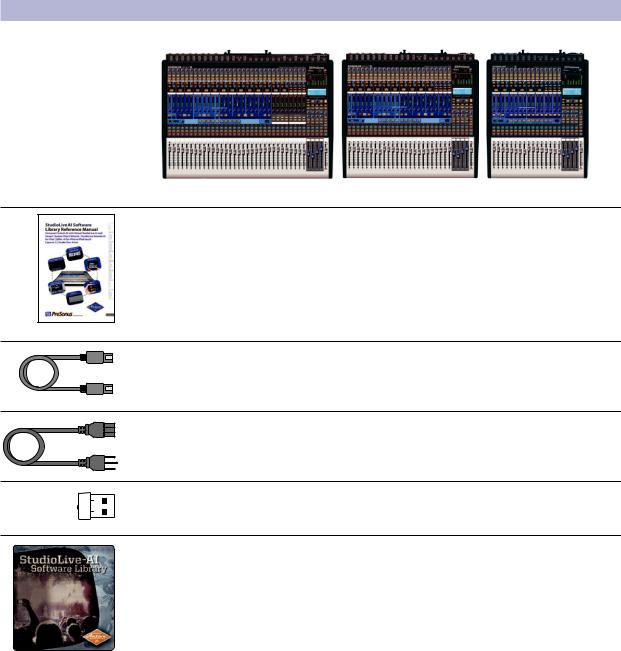
1 |
Overview |
StudioLive™ 32.4.2AI |
1.3 |
Summary of StudioLive AI-series Mixer Hardware Features |
Owner’s Manual |
•• Talkback-communication system
•• Windows® and Mac® compatible
•• Powerful StudioLive Software Library includes:
•• Virtual StudioLive-AI (VSL-AI) advanced editor/librarian/control software
•• StudioLive Remote-AI (SL Remote-AI) remote control app for iPad® (free from Apple App Store)
•• QMix™-AI remote aux-mix app for iPhone®/ iPod touch® (free from Apple App Store)
•• Capture™ integrated multitrack-recording software
•• Studio One® Artist digital audio workstation with more than 6 GB of plug-ins, loops, and sounds
1.4What is in the Box
In addition to this manual, your StudioLive package contains the following:
•• PreSonus StudioLive AI-series digital recording and performance mixer
•• StudioLive AI Software Library Reference Manual
•• 6-foot (1.8 meter), 9-pin-to-9-pin FireWire s800 cable
•• IEC power cord
•• USB wireless LAN adapter
•• StudioLive Software Library containing:
•• PreSonus Studio One Artist program DVD plus gigabytes of third-party content
•• PreSonus Capture CD with demo sessions
•• Download instructions for:
-- Universal Control AI with VSL-AI -- SL Remote AI for iPad®
-- QMix™ AI for iPhone®/iPod® touch
3
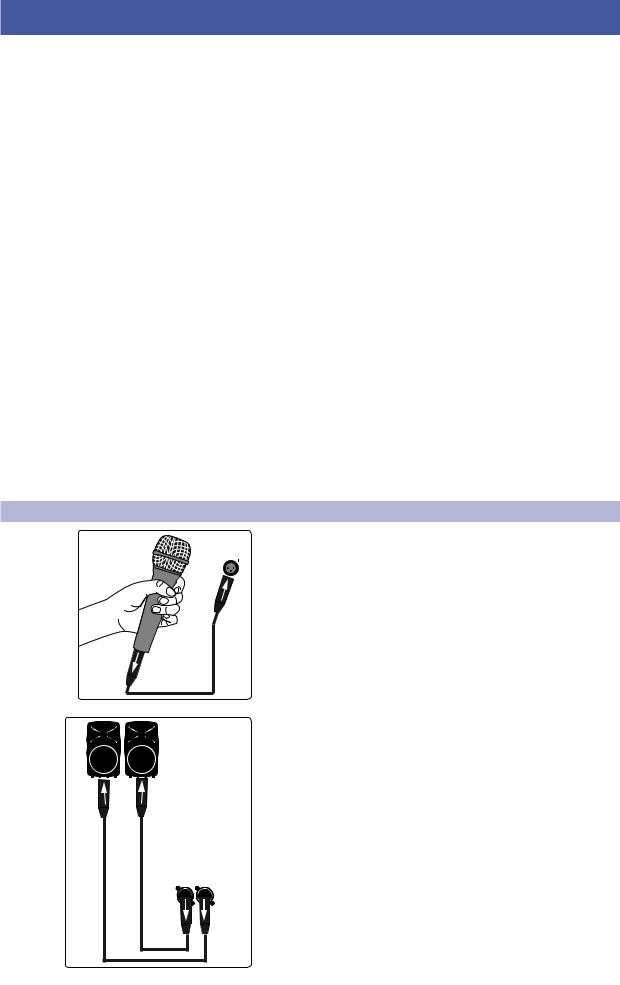
2 |
Getting Started |
StudioLive™ 32.4.2AI |
2.1 |
Level Setting Procedure |
Owner’s Manual |
2 Getting Started
Before you begin, here are a few general rules of thumb:
•• Always turn the Main fader and both the Monitor and Phones knobs in the Monitor section down before making connections.
•• Before plugging or unplugging a microphone while other channels are active, mute the channel to which you are connecting.
•• Your faders should be set on or near the“U”mark whenever possible. The“U” indicates unity gain, meaning the signal is neither boosted nor attenuated. If the main output of your StudioLive is too high or too low when your faders are at or near unity, you can use the output-level knob on the rear panel of the StudioLive to adjust the level up or down until you have achieved the optimal volume.
•• Do not allow your inputs to clip. Watch the level meters; when the LEDs near the Clip mark, the top LED will illuminate, indicating that the analog-to-digital converters are in danger of being overdriven. Overdriving the converters
will cause digital distortion, which sounds terrible. The XMAX™ preamps in your StudioLive provide plenty of headroom; take advantage of it.
Your P.A. and studio equipment should be powered on in the following order:
1.Sound sources (keyboards, direct boxes, microphones, etc.) connected to the StudioLive inputs
2.StudioLive AI mixer
3.Computer (if applicable)
4.Power amplifiers or powered monitors
When it’s time to power down, your system should be turned off in the reverse order. Now that you know what not to do, let’s get some audio going!
2.1Level Setting Procedure
1. Grab a microphone and a mic cable and plug them into the StudioLive’s Channel 1 mic input.
2.Connect the Main outs (TRS or XLR) of your StudioLive to your power amplifier or powered monitors.
4

2 |
Getting Started |
StudioLive™ 32.4.2AI |
||||||||||
2.1 |
Level Setting Procedure |
Owner’s Manual |
||||||||||
|
3. |
If you’re using passive speakers, connect them to your power |
||||||||||
|
|
|
|
|
|
|
|
|
|
|
|
amplifier using speaker cable. |
|
|
|
|
|
|
|
|
|
|
|
|
|
|
|
|
|
|
|
|
|
|
|
|
|
|
|
|
|
|
|
|
|
|
|
|
|
|
|
|
|
|
|
|
|
|
|
|
|
|
|
|
|
|
|
|
|
|
|
|
|
|
|
|
|
|
|
|
|
|
|
|
|
|
|
|
|
|
|
|
|
|
|
|
|
|
|
|
|
|
|
|
|
|
|
|
|
|
|
|
|
|
|
|
|
|
|
|
|
|
|
|
|
|
|
|
|
|
|
|
|
|
|
|
|
|
|
|
|
|
4.Bring down all the faders on your StudioLive to the ∞ setting.
5.Make sure that the Mic/Line knob on Channel 1 is all the way
counter-clockwise.
6. Plug your StudioLive into a power outlet and turn it on.
5

2 |
Getting Started |
StudioLive™ 32.4.2AI |
2.1 |
Level Setting Procedure |
Owner’s Manual |
|
7. |
If your microphone requires phantom power, engage the 48V |
|
|
button on Channel 1 of your StudioLive. |
8. Turn on your amplifier or powered monitors.
9. Press the Input button in the Meters section.
10.Speak or sing into your microphone at approximately the same volume you expect during the performance.
6

2 |
Getting Started |
StudioLive™ 32.4.2AI |
2.1 |
Level Setting Procedure |
Owner’s Manual |
11. Turn the trim knob on Channel 1 clockwise while watching the first meter in the Fat Channel. Adjust the Channel 1 trim knob until a little more than half of the green LEDs are lit. The red LED at the top of the meter should never light up.
12. Press the Select button on Channel 1.
13. Raise the Channel 1 fader until it reaches“U”(unity gain).
14. Press the Main button in the Assign section of the Fat Channel so that it illuminates. This routes the channel to the main output bus.
7
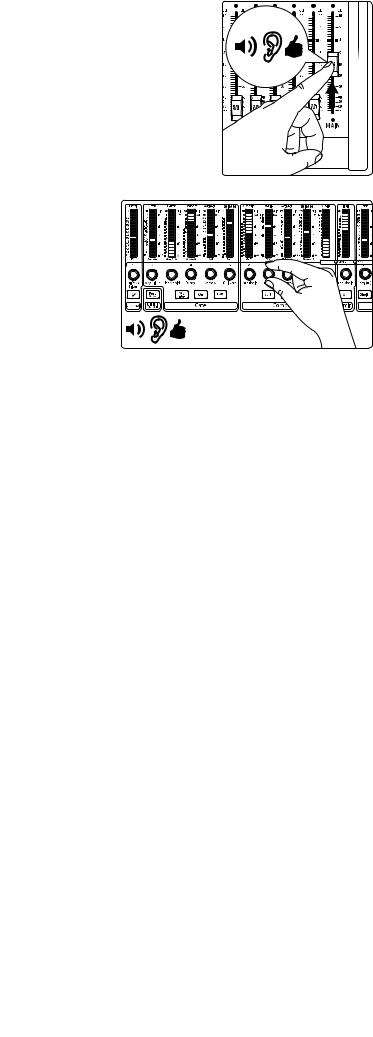
2 |
Getting Started |
StudioLive™ 32.4.2AI |
2.1 |
Level Setting Procedure |
Owner’s Manual |
|
|
15. Bring up the Main fader until you can comfortably listen to |
|
|
your microphone through your speakers. |
16. With Channel 1 selected, you can use the Fat Channel to add dynamics processing and EQ.
8
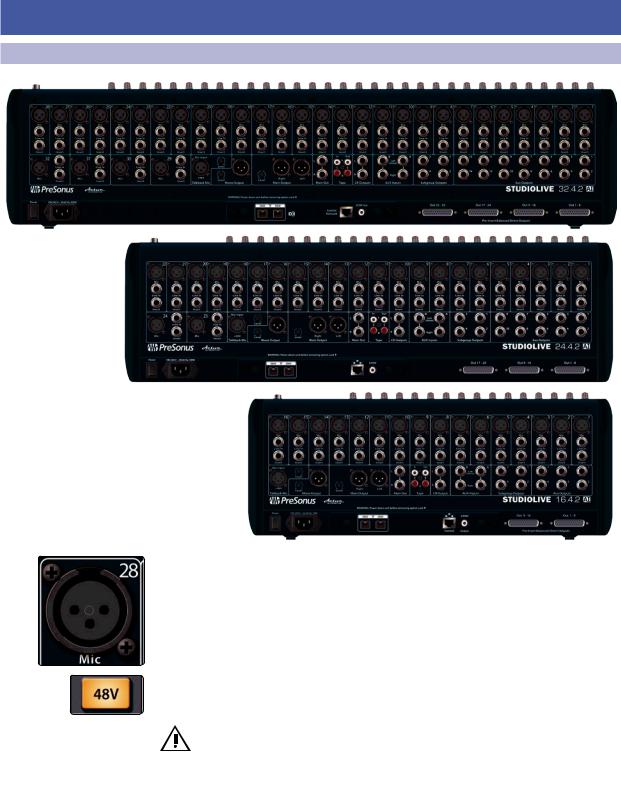
3 |
Hookup |
StudioLive™ 32.4.2AI |
3.1 |
Rear-Panel Connections |
Owner’s Manual |
3Hookup
3.1Rear-Panel Connections
Microphone Inputs. Your StudioLive is equipped with 32/24/16 PreSonus XMAX microphone preamplifiers for use with all types of microphones. The XMAX preamplifier has a Class A input buffer, followed by a dual-servo gain stage. This arrangement results in ultra-low noise and wide gain control, allowing you to boost signals without increasing unwanted background noise.
48-volt Phantom Power. The StudioLive provides 48V phantom power for the microphone input on each channel. This feature can be individually enabled for each channel using buttons on the top panel.
WARNING: Phantom power is required for condenser microphones but can severely damage some dynamic mics, especially ribbon mics. Therefore, switch
phantom power off for all channels where it is not required.
Power User Tip: Dynamic microphones and ribbon microphones are generally lower-output devices and require no external power source. The most important thing to note about ribbon microphones is that they very rarely require phantom power. In fact, unless a ribbon microphone calls specifically for phantom power, sending phantom power to it can cause severe damage. Condenser microphones are generally more sensitive than dynamic and ribbon microphones and typically require external +48V phantom power. Always review your microphone’s documentation to ascertain the manufacturer’s recommended operating practices.
XLR connector wiring for phantom power: Pin 1 = GND Pin 2 = +48V Pin 3 = +48V
9
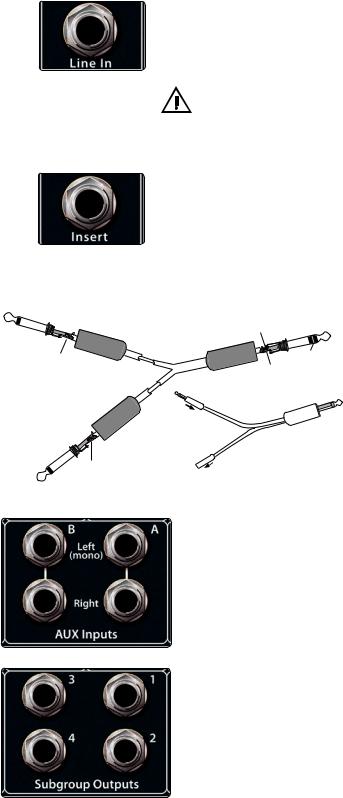
3 |
Hookup |
StudioLive™ 32.4.2AI |
3.1 |
Rear-Panel Connections |
Owner’s Manual |
Tip (Return)
Tip (Send)
Line-level Inputs. Each channel of the StudioLive has a ¼-inch, balanced TRS connection for line-level input. When these inputs are engaged, the microphonepreamp circuit is bypassed. Typical examples of line-level connections are synthesizer outputs, CD/DVD-player outputs, and (with exceptions) signal-processor inputs and outputs.
Note: As with any mixer, plugging in a microphone or a line-level input device, or turning phantom power on or off, will create a momentary spike in the audio
output of your StudioLive. Because of this, it is highly recommended that you mute or turn down the channel trim before changing connections or turning phantom power on or off. This simple step will add years to life of your audio equipment.
Insert. Each input channel on the StudioLive has a direct-insert point. These unbalanced, ¼-inch connectors can be used to connect external processors (such as compressors, EQs, de-essers, and filters) to your StudioLive’s channel inputs. The insert’s send is after the channel’s gain control but before the digital bus. The return goes straight to the digital bus. So if you insert a de-esser on your vocalist’s channel, you will be sending an unprocessed, amplified signal to the de-esser; the processed signal returned to the StudioLive will then be routed to the digital bus, where it can be sent through the Fat Channel, Aux and FX buses, etc.
From  processor
processor
output
To  processor
processor
input
Ring (In)
 Tip
Tip
Tip (Out)
Ring (Send) (Return)
To mixer channel insert
Insert-connector wiring:
Tip = send (output to inserted device) Ring = return (input from inserted device) Sleeve = common ground
Aux Inputs. The StudioLive offers two auxiliary inputs. While these line inputs are generally used as effects returns, they can also be used for any line-level source (synthesizers, amp modelers, etc.). In Section 4.4.7, we discuss using an aux bus to send several channels to an external effects processor; the aux inputs can be used to return the processed signal to the mixer. Each input is balanced stereo. The left input is normalled to the right input, so if you are returning a mono signal to the mix, connect it to the left input, and the signal will be routed to both sides of the mix.
Subgroup Outputs. These are balanced mono outputs for each subgroup.
10

3 |
Hookup |
StudioLive™ 32.4.2AI |
3.1 |
Rear-Panel Connections |
Owner’s Manual |
Aux Outputs. The StudioLive is equipped with 14/10/6 auxiliary outputs. Aux mixes are routed to these outputs. In Section 4.4.5 and 4.4.6, we discuss in detail how to create aux mixes for monitoring and effects processing.
Talkback Mic Input. The StudioLive does not have an onboard talkback mic; an external mic must be used. Phantom power is always enabled on the Talkback microphone preamp, so either a dynamic or a condenser microphone can be used. However, we recommend reviewing the documentation that came with your dynamic microphone to verify that phantom power will not harm it.
Power User Tip: The Talkback microphone preamp is the same high-quality XMAX preamp that is featured on StudioLive channel mic inputs. The Talkback input can also be selected as a recording input. See “Auxiliary Digital
Sends” in the StudioLive AI-Series Software Library Manual for details.
Talkback Mic Level. This is the trim control for your talkback microphone. It adjusts the gain of the talkback input.
Mono Output. This balanced output carries a mono, summed version of the stereo signal from the Main bus.
Mono Output Level. This knob controls the maximum level of the Mono Output signal. The signal can be attenuated to -80 dB and boosted up to +6 dB.
Main Output. The StudioLive features both XLR and TRS main outputs. These outputs are parallel to each other and to the mono output.
Main Output Level. This knob controls the maximum output level of the XLR and TRS main outputs. The signal can be attenuated to -40 dB and boosted up to 0 dB.
Power User Tip: All StudioLive main outputs (XLR stereo, TRS stereo, and XLR mono) are active all of the time. Therefore, you can send your main mix to five speakers
at the same time. This can be especially useful when you need to send a mix to another room or add another set of speakers to accommodate a larger venue.
11
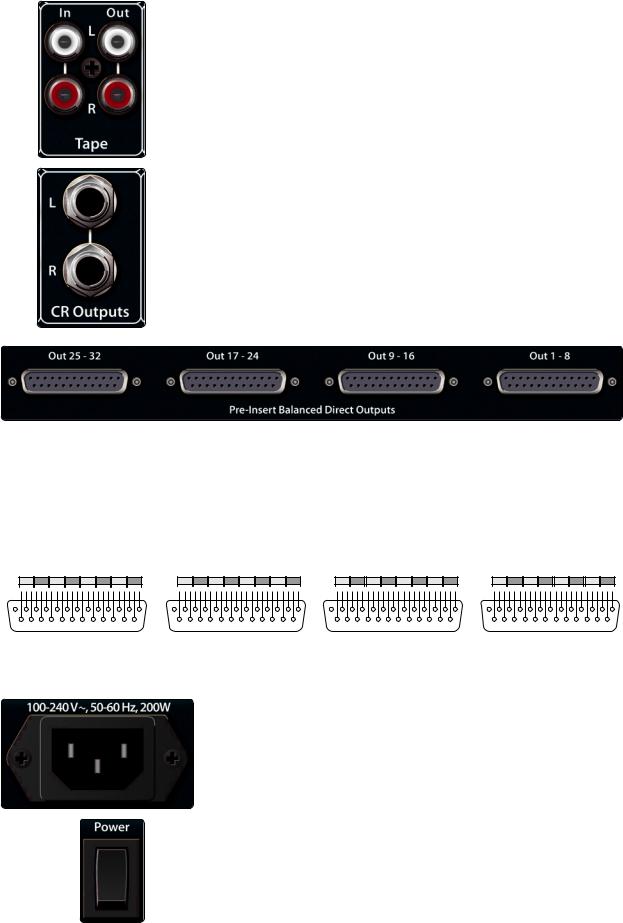
3 |
Hookup |
StudioLive™ 32.4.2AI |
3.1 |
Rear-Panel Connections |
Owner’s Manual |
Tape In/Out. The StudioLive is equipped with stereo RCA inputs and outputs that can be used to connect a tape deck, CD player, or other consumer device. The tape-input level is controlled by the 2 Track In knob on the top panel. The Main bus is routed post-fader to the tape output.
CR Outputs. These are the balanced control-room outputs. The level is controlled by the Monitor knob in the Monitor section on the top panel.
Pre-Insert Balanced Direct Outputs. These are the balanced, direct analog outputs for the 32/24/16 channels. The DB25 connectors divide the channels into groups of eight. Balanced DB25 fan-out snakes can be obtained in various configurations at most recording and live-sound retailers. Common fan-outs are DB25 to (8) XLRM and DB25 to (8) TRS.
These outputs are post-gain, pre-insert, and pre-A/D converter. Only the microphone preamps and line-level inputs are available through the direct outputs. The digital returns cannot be patched to the direct outputs.
|
25 |
26 |
|
27 |
28 |
29 |
30 |
31 |
|
32 |
|
17 |
18 |
|
19 |
20 |
21 |
22 |
23 |
|
24 |
|
|
9 |
10 |
|
11 |
12 |
13 |
|
14 |
15 |
16 |
|
|
|
1 |
|
2 |
|
3 |
|
4 |
|
5 |
|
6 |
|
7 |
|
8 |
||||||||||||||
|
G C H G C H G C H G C H G C H G C H G C H G C H |
|
G C H G C H G C H G C H G C H G C H G C H G C H |
|
G C H G C H G C H G C H G C H G C H G C H G C H |
|
G C H G C H G C H G C H G C H G C H G C H G C H |
||||||||||||||||||||||||||||||||||||||||||||||||||||||||||
13 |
12 |
11 |
10 |
|
9 |
8 |
7 |
6 |
5 |
4 |
3 |
2 |
1 |
13 |
12 |
11 |
10 |
|
9 |
8 |
7 |
6 |
5 |
4 |
3 |
2 |
1 |
13 |
12 |
11 |
10 |
9 |
8 |
7 |
6 |
|
5 |
4 |
|
3 |
2 |
1 |
13 |
12 |
11 |
10 |
9 |
|
8 |
7 |
6 |
5 |
4 |
|
3 |
2 |
1 |
||||||||
25 |
24 |
|
23 |
22 |
21 |
20 |
19 |
18 |
17 |
16 |
15 |
|
14 |
25 |
24 |
|
23 |
22 |
21 |
20 |
19 |
18 |
17 |
16 |
15 |
|
14 |
25 |
24 |
|
23 |
22 |
21 |
20 |
19 |
18 |
|
17 |
16 |
15 |
14 |
|
25 |
24 |
|
23 |
22 |
|
21 |
20 |
19 |
18 |
|
17 |
16 |
15 |
|
14 |
|||||||
|
|
|
|
|
|
|
|
|
|
|
|
|
|
|
|
|
|
|
|
|
|
|
|
Pre-Insert Balanced Direct Outputs |
|
|
|
|
|
|
|
|
|
|
|
|
|
|
|
|
|
|
|
|
|
|
|
|
|||||||||||||||||
|
|
|
|
|
|
|
|
|
|
|
|
|
|
|
|
DB25 pin-outs: |
H = Hot |
C = Cold G = Ground |
|
|
|
|
|
|
|
|
|
|
|
|
|
|
|
|
|
|
|||||||||||||||||||||||||||||
Power-cable Input. This is where you plug in the provided IEC power cable.
Power Switch. Push the top part of the switch ( | ) to turn on your StudioLive. Push the bottom part of the switch ( O ) to turn it off.
12
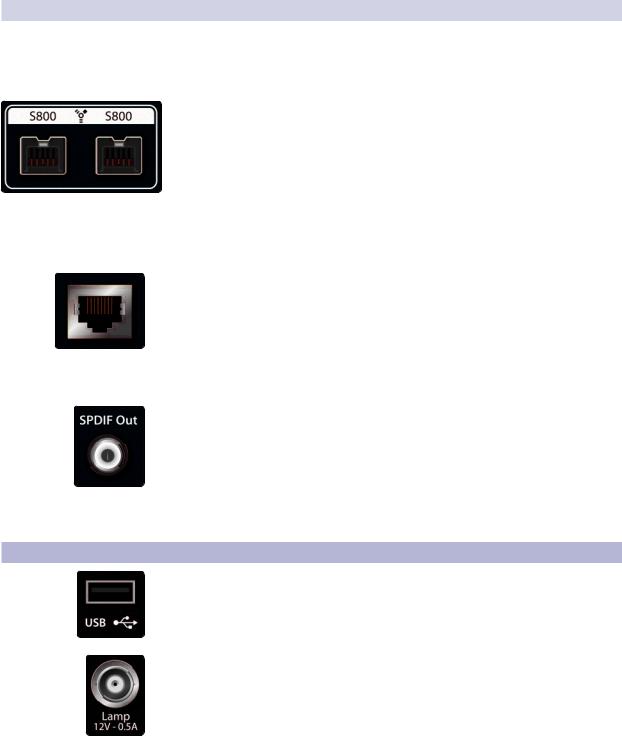
3 |
Hookup |
StudioLive™ 32.4.2AI |
3.2 |
Front Panel Connections |
Owner’s Manual |
3.1.1 Installed Option Card
Each StudioLive AI-series mixer includes an installed option card that provides FireWire s800 connectivity, Ethernet for remote control, and S/PDIF output. For more information about user-installable StudioLive AI-series mixer option cards and their availability, please visit www.presonus.com.
FireWire s800 Ports. There are two standard 9-pin FireWire s800 ports on the back of the StudioLive. Either port can be used to connect the StudioLive to a FireWire s800 port on your computer. Use the second FireWire s800 port to
connect additional s800 devices (such as external hard drives) to your computer.
Please note: While connecting your StudioLive AI-series mixer to a FireWire 400 connection on your computer and daisy-chaining a FireWire 400 device to the
secondary s800 port are supported, this will reduce your StudioLive bus speed to 400 Mbps, and you may experience reduced performance. To experience the full power of your StudioLive AI-series mixer, it is highly recommended that you connect to a true s800 connection or to a Thunderbolt connection using an adapter.
Ethernet. This standard RJ45 connection has been included to hardwire your StudioLive to a LAN network. By adding a wireless router to the network, you will be able to wirelessly remote control your StudioLive from virtually anywhere. This is especially useful when your wireless control devices (iPad, iPhone, or iPod touch) must be used in a different room from where your StudioLive is installed, or if there is quite a bit of wireless interference in your venue. For more information on connecting your StudioLive to a LAN network, please review “Networking your StudioLive AI Mixer” in the StudioLive AI-Series Software Library Manual.
S/PDIF Output. By default, the S/PDIF output receives the same signal as the main outputs, so no activation is necessary. However, any bus can be routed to the S/PDIF output, either through the System menu in the Digital Effects | Master Control section, or in VSL-AI. (See Section 5.5 in this manual or “VSL-AI: Setup Tab” in the StudioLive AI-Series Software Library Manual for more information.) Because the StudioLive cannot be synced externally, you will need to use it as the master clock and set your S/PDIF-equipped device to receive word clock externally via S/PDIF. Please consult the documentation for your external digital device for instructions.
3.2Front Panel Connections
USB. The USB port is for use with the included USB Wi-Fi module. This module will allow you to connect your StudioLive AI-series mixer to a wireless network and remote control it using VSL-AI, SL Remote-AI, and QMix-AI. More information about wireless networking can be found in “Networking your StudioLive AI Mixer” in the
StudioLive AI-Series Software Library Manual.
This 12V BNC connection is provided to connect a third-party console lamp. Do not use a bulb that is larger than 6W.
13
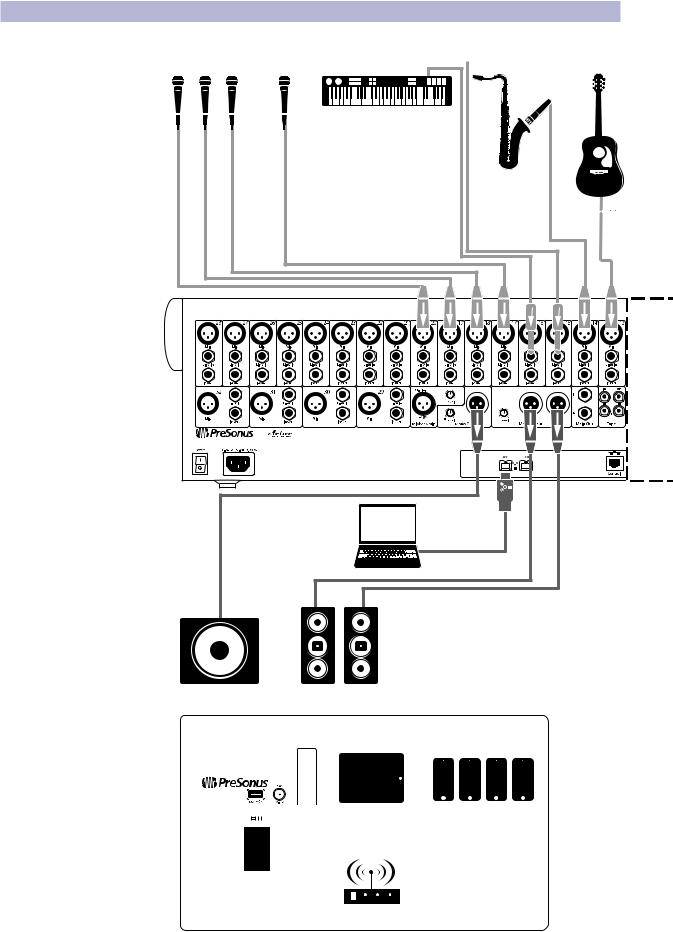
3 |
Hookup |
StudioLive™ 32.4.2AI |
3.3 |
Typical Band Setup Diagrams |
Owner’s Manual |
3.3Typical Band Setup Diagrams
|
|
|
|
|
|
keyboard/DI |
|
|
acoustic |
|||
backup vocal mics |
lead vocal |
|
sax |
guitar/DI |
||||||||
|
||||||||||||
|
|
|
|
|
|
|
|
|
|
|
|
|
|
|
|
|
|
|
|
|
|
|
|
|
|
|
|
|
|
|
|
|
|
|
|
|
|
|
|
|
|
|
|
|
|
|
|
|
|
|
|
|
|
|
|
|
|
|
|
|
|
|
|
|
|
|
|
|
|
|
|
|
|
|
|
|
|
|
|
|
|
|
|
|
|
|
|
|
|
|
WARNING: Power down unit before removing option card |
laptop running |
Capture 2.0 |
subwoofer |
front of house |
|
speakers |
StudioLive control surface
|
|
|
|
|
|
|
|
|
|
|
|
|
|
|
|
|
|
|
|
|
|
|
|
|
|
|
|
|
|
|
|
|
|
|
|
|
|
|
|
|
|
|
|
|
|
|
|
|
|
|
|
|
|
|
|
|
|
|
|
|
|
|
|
|
|
|
|
|
|
|
|
|
|
|
|
|
|
|
|
|
|
|
|
|
|
|
|
|
|
|
|
|
|
|
|
|
iPad running |
iPhones running QMix-AI |
||||||||||||||||
|
|
|
|
|
||||||||||||||||||
|
|
|
|
|
SL Remote-AI |
|
|
|
|
|
|
|
|
|
||||||||
|
|
|
|
|
|
|
|
|
|
|
|
|
|
|||||||||
<![endif]>




 WIFI
WIFI
USB Wireless
LAN adapter
wireless router
14
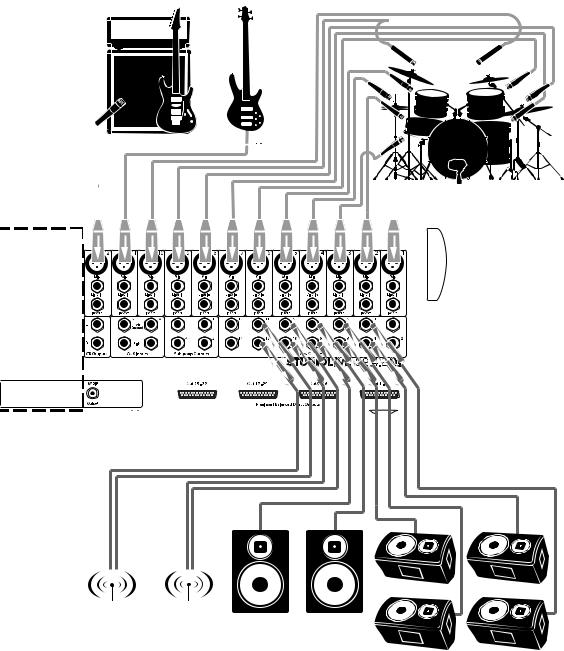
3 |
Hookup |
StudioLive™ 32.4.2AI |
3.3 |
Typical Band Setup Diagrams |
Owner’s Manual |
|
|
|
electric guitar amp |
|
bass/DI |
drum kit |
||||||||||||||
|
|
|
|
|
|
|
|
|
|
|
|
|
|
|
|
|
|
|
|
|
|
|
|
|
|
|
|
|
|
|
|
|
|
|
|
|
|
|
|
|
|
|
|
|
|
|
|
|
|
|
|
|
|
|
|
|
|
|
|
|
|
|
|
|
|
|
|
|
|
|
|
|
|
|
|
|
|
|
|
|
|
|
|
|
|
|
|
|
|
|
|
|
|
|
|
|
|
|
|
|
|
|
|
|
|
|
|
|
|
|
|
|
|
|
|
|
|
|
|
|
|
|
|
|
|
|
|
|
|
|
|
|
|
|
|
|
|
|
|
|
|
|
|
|
|
|
|
|
|
|
|
|
|
|
|
|
|
|
|
|
|
|
|
|
|
|
|
|
|
|
|
|
|
|
|
|
|
|
|
|
|
|
|
|
|
|
|
|
|
|
|
|
|
|
|
|
|
|
|
|
|
|
|
|
|
|
|
|
|
|
|
|
|
|
|
|
|
|
|
|
|
|
|
|
|
|
|
|
|
|
|
|
|
|
|
|
|
|
|
|
|
|
|
|
|
|
|
|
|
|
|
|
|
|
|
|
|
|
|
|
|
|
|
|
|
|
|
|
|
|
|
|
|
|
|
|
|
|
|
|
|
|
|
|
|
|
|
|
|
|
|
|
|
wireless in-ear |
wireless in-ear drum monitor |
side ll |
(keys) |
(lead vocals) |
|
oor wedges
15

3 |
Hookup |
StudioLive™ 32.4.2AI |
3.4 |
Typical Church Setup Diagrams |
Owner’s Manual |
3.4Typical Church Setup Diagrams
hanging |
|
|
|
|
podium |
|
|
mics |
|
acoustic |
|||||||||||||||||
choir mics |
|
|
|
|
mic |
|
|
|
guitar/DI |
||||||||||||||||||
|
|
|
|
|
|
|
|
|
|
|
|
|
|
|
|
|
|
|
|
|
|
|
|
|
|
|
|
|
|
|
|
|
|
|
|
|
|
|
|
|
|
|
|
|
|
|
|
|
|
|
|
|
|
|
|
|
|
|
|
|
|
|
|
|
|
|
|
|
|
|
|
|
|
|
|
|
|
|
|
|
|
|
|
|
|
|
|
|
|
|
|
|
|
|
|
|
|
|
|
|
|
|
|
|
|
|
|
|
|
|
|
|
|
|
|
|
|
|
|
|
|
|
|
|
|
|
|
|
|
|
|
|
|
|
|
|
|
|
|
|
|
|
|
|
|
|
|
|
|
|
|
|
|
|
|
|
|
|
|
|
|
|
|
|
|
|
|
|
|
|
|
|
|
|
|
|
|
|
|
|
|
|
|
|
|
|
|
|
|
|
|
|
|
|
|
|
|
|
|
|
|
|
|
|
|
|
|
|
|
|
|
|
|
|
|
|
|
|
|
|
|
|
|
|
|
|
|
|
|
|
|
|
|
|
|
|
|
|
|
|
|
|
|
|
|
|
|
|
|
|
|
|
|
|
|
|
|
|
|
|
|
|
|
|
|
|
|
|
|
|
|
|
|
|
|
|
|
|
|
|
|
|
|
|
|
|
|
|
|
|
|
|
|
|
|
|
|
|
|
|
|
|
|
|
|
|
|
|
|
|
|
|
|
|
|
|
|
|
|
|
|
|
|
|
|
|
|
|
|
|
|
|
|
|
|
|
|
|
|
|
|
|
|
|
|
|
|
|
|
|
|
|
|
|
|
|
|
|
|
|
|
|
|
|
|
|
|
|
|
|
|
|
|
|
|
|
|
|
|
|
|
|
|
|
|
|
|
|
|
|
|
|
|
|
|
|
|
|
|
|
|
|
|
|
|
|
|
|
|
|
|
|
|
|
|
|
|
|
|
|
|
|
|
|
|
|
|
|
|
|
|
|
|
|
|
|
|
|
|
|
|
|
|
|
|
|
|
|
|
|
|
|
|
|
|
|
|
|
|
|
|
|
|
|
|
|
|
|
|
|
|
|
|
|
|
|
|
|
|
|
|
|
|
|
|
|
|
|
|
|
|
|
|
|
|
|
|
|
|
|
|
|
|
|
|
|
|
|
|
|
|
|
|
|
|
|
|
|
|
|
|
|
|
|
|
|
|
|
|
|
|
|
|
|
|
|
|
|
|
|
|
|
|
|
|
|
|
|
|
|
|
|
|
|
|
|
|
|
|
|
|
|
|
|
|
|
|
|
|
|
|
|
|
|
|
|
|
|
|
|
|
|
|
|
|
|
|
down unit before |
card |
subwoofers
|
|
|
dvd player |
cry room |
laptop running |
|
|
Capture 2.0 |
front of house speakers
16
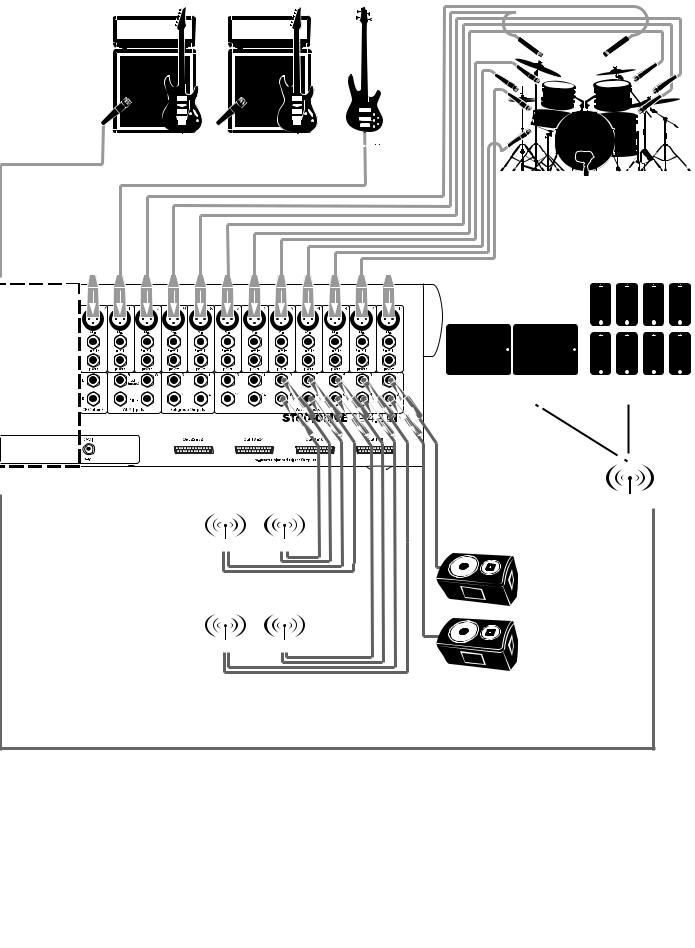
3 |
Hookup |
StudioLive™ 32.4.2AI |
3.4 |
Typical Church Setup Diagrams |
Owner’s Manual |
|
electric guitar |
|
electric guitar |
|
|
|
|
|
|
|
|
|
|
|
|
|
|
|
|
drum kit |
|
|
|
|
|
|
||||||
|
amp (rhythm) |
|
amp (lead) |
bass/DI |
|
|
|
|
|
|
|
|
|
|
|
|
|
|
|
|
|
|
|
|||||||||
|
|
|
|
|
|
|
|
|
|
|
|
|
|
|
|
|
|
|
|
|
|
|
|
|
|
|
|
|
|
|
|
|
|
|
|
|
|
|
|
|
|
|
|
|
|
|
|
|
|
|
|
|
|
|
|
|
|
|
|
|
|
|
|
|
|
|
|
|
|
|
|
|
|
|
|
|
|
|
|
|
|
|
|
|
|
|
|
|
|
|
|
|
|
|
|
|
|
|
|
|
|
|
|
|
|
|
|
|
|
|
|
|
|
|
|
|
|
|
|
|
|
|
|
|
|
|
|
|
|
|
|
|
|
|
|
|
|
|
|
|
|
|
|
|
|
|
|
|
|
|
|
|
|
|
|
|
|
|
|
|
|
|
|
|
|
|
|
|
|
|
|
|
|
|
|
|
|
|
|
|
|
|
|
|
|
|
|
|
|
|
|
|
|
|
|
|
|
|
|
|
|
|
|
|
|
|
|
|
|
|
|
|
|
|
|
|
|
|
|
|
|
|
|
|
|
|
|
|
|
|
|
|
|
|
|
|
|
|
|
|
|
|
|
|
|
|
|
|
|
|
|
|
|
|
|
|
|
|
|
|
|
|
|
|
|
|
|
|
|
|
|
|
|
|
|
|
|
|
|
|
|
|
|
|
|
|
|
|
|
|
|
|
|
|
|
|
|
|
|
|
|
|
|
|
|
|
|
|
|
|
|
|
|
|
|
|
|
|
|
|
|
|
|
|
|
|
|
|
|
|
|
|
|
|
|
|
|
|
|
|
|
|
|
|
|
|
|
|
|
|
|
|
|
|
|
|
|
|
|
|
|
|
|
|
|
|
|
|
|
|
|
|
|
|
|
|
|
|
|
|
|
|
|
|
|
|
|
|
|
|
|
|
|
|
|
|
|
|
|
|
|
|
|
|
|
|
|
|
|
|
|
|
|
|
|
|
|
|
|
|
|
|
|
|
|
|
|
|
|
|
|
|
|
|
|
|
|
|
|
|
|
|
|
|
|
|
|
|
|
|
|
|
|
|
|
|
|
|
|
|
|
|
|
|
|
|
|
|
|
|
|
|
|
|
|
|
|
|
|
|
|
|
|
|
|
|
|
|
|
|
|
|
|
|
|
|
|
iPads running |
iPhones running QMix-AI |
||||
|
|
|
SL Remote-AI |
|
|
|
|
|
|
|
|
|
|
|
|
|
|
|
|
|
|
|
|
|
|
|
|
|
|
|
|
|
|
|
|
wireless router
|
|
|
|
|
|
|
|
|
|
wireless in-ear |
wireless in-ear |
||||||||
|
|
(keys) |
|
(lead vocals) |
|||||
|
|
|
|
|
|
|
|
|
|
|
|
|
|
|
|
|
|
|
|
wireless in-ear |
wireless in-ear |
floor wedges |
(bass) |
(lead guitar) |
|
17

4 |
Controls |
StudioLive™ 32.4.2AI |
4.1 |
The Fat Channel |
Owner’s Manual |
4Controls
4.1The Fat Channel
The revolutionary Fat Channel is the heart of the StudioLive. The Fat Channel makes dynamics, routing, and panning for every input and output on the StudioLive available at the touch of a Select button. The 32/24/16 multipurpose knobs and meters located in the Fat Channel control nearly every adjustment you will need to make on your StudioLive. From the Fat Channel, you can:
•• Add dynamics processing and EQ to every input and output and A/B them
•• Create sends and effects mixes for every analog aux bus and internal effects buses
•• Assign subgroup and main routing
•• Meter inputs, post-dynamics-processing outputs, and gain reduction for every input channel
•• Meter aux-send outputs
•• Copy, save, and load mix scenes
•• Recall your fader position for stored mixes
4.1.1 Select Buttons, Meters, and the Fat Channel
Select Buttons. All around the StudioLive, you will see Select buttons. There is a Select button on each of the input channels, each of the analog aux buses, all of the internal FX (effects) buses, each of the subgroups, both auxiliary inputs, and the main output bus. Each of these buttons serves exactly the same purpose: to access the available Fat Channel parameters for its channel or bus.
It should be noted that while the noise gate, compressor, EQ, and limiter are available on every input channel and bus, the high-pass filter is only available on the input channels, aux buses, and internal FX buses, and Polarity Invert is only available on the input channels.
Selected Channel Display. In the lower right corner of the Fat Channel, you will find an LED readout. The currently selected channel will always be displayed here.
•• Input Channels: Channel number
•• Subgroup: S1-S4
•• Aux Outputs: A1-A9, AA-AE
•• FX Buses A-D: FA-FD
•• Auxiliary Input A and B: RA and RB
•• Main Bus: MA
Selected Channel Meters. In addition, two meters—part of a set of eight meters located in the top right section of the mixer—are dedicated to displaying information about the currently selected channel. The meter on the far left of this section displays the pre-fader input level for the selected channel. The meter to the right of it displays the gain reduction applied to the selected channel. It is important to mention that these meters are only active when one of the input channels or an aux bus is selected.
18

4 |
Controls |
StudioLive™ 32.4.2AI |
4.1 |
The Fat Channel |
Owner’s Manual |
|
|
Channel Info Page. When a channel or output bus is |
|
|
selected, the Channel Info page will open in the LCD. This is |
|
|
the default screen for your StudioLive. From this page you |
|
|
can customize the name for each channel or bus and view |
|
|
helpful information about each channel and bus on your |
|
|
StudioLive mixer. See Section 5.1 for more information. |
4.1.2 Fat Channel Processing Guide
The following table provides a quick guide to the processing that is available for each bus in the StudioLive. Note that all of these inputs and buses can be recorded. For more information on digital sends, please see “Digital
Sends and Returns” in the StudioLive AI-Series Software Library Manual.
Bus |
Phase |
High-Pass |
Noise |
Compressor |
EQ |
Limiter |
Digital |
|
Reverse |
Filter |
Gate |
|
|
|
Send |
|
|
|
|
|
|
|
|
Inputs Channels |
|
|
|
|
|
|
|
|
|
|
|
|
|
|
|
Subgroups |
|
|
|
|
|
|
|
|
|
|
|
|
|
|
|
Main Out L/R |
|
|
|
|
|
|
|
|
|
|
|
|
|
|
|
Aux Buses |
|
|
|
|
|
|
|
|
|
|
|
|
|
|
|
FX Buses |
|
|
|
|
|
|
|
|
|
|
|
|
|
|
|
Auxiliary Stereo Inputs |
|
|
|
|
|
|
|
|
|
|
|
|
|
|
|
Tape Input |
|
|
|
|
|
|
|
|
|
|
|
|
|
|
|
Talkback Mic |
|
|
|
|
|
|
|
|
|
|
|
|
|
|
|
Solo Bus |
|
|
|
|
|
|
|
|
|
|
|
|
|
|
|
4.1.3 Fat Channel: Dynamics Processing and EQ
The main function of the Fat Channel is to provide dynamics processing and filtering for every input and output on the StudioLive. The rotary encoders work in conjunction with the meters directly above them to adjust and display the dynamics processing and EQ parameters. The Fat Channel’s processing section consists of
five parts: high-pass filter, noise gate, compressor, limiter, and parametric EQ. Each can be turned on or off and controlled separately. The signal flows as follows:
Ø  Hi-Pass
Hi-Pass  Noise Gate
Noise Gate Compressor
Compressor EQ
EQ  Limiter
Limiter
Polarity Invert. Push this button to invert the polarity of the selected channel’s signal (that is, to alter the polarity by 180°). The button will illuminate, indicating that Polarity Invert is active. The Polarity Invert button can be used to correct audio signals that are out of phase and are canceling/reinforcing each other.
Power User Tip: When recording with more than one open microphone, use the polarity invert to combat phase cancellation between microphones.
Polarity Invert is only available on the 32/24/16 channels of the input bus.
19
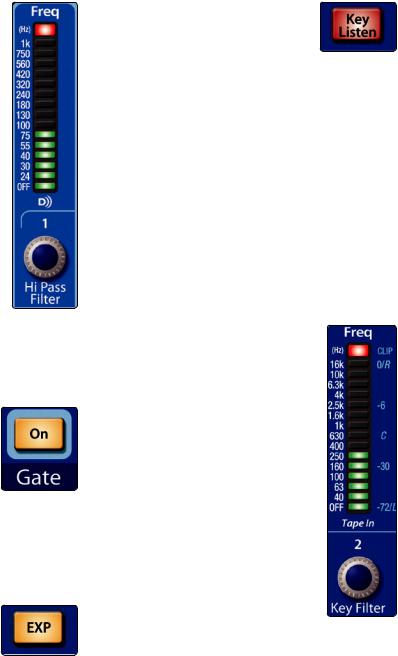
4 Controls
4.1The Fat Channel
High Pass Filter. Sets the High-Pass Filter Frequency Threshold for the Selected Channel or Output Bus.
The High Pass Filter section consists of an encoder and a meter. Frequency range is
indicated to the left of the meter. The filter’s threshold can be set from 24 Hz to 1 kHz. When the meter is set to its lowest point, the filter is off. The high-pass filter’s slope is -12 dB/8va.
Power User Tip: A high-pass filter attenuates all frequencies below the set threshold. Use the Fat Channel high-pass filter to
remove unwanted low-frequencies from your source signal, rather than trying to EQ them out.
The high-pass filter is available on the 32/24/16 channels of the input bus and on every analog aux and internal FX bus.
Gate On/Off Button. Turns the Gate On and Off for the Selected Channel.
This button engages and disengages the gate for the selected channel. It will illuminate to indicate that the gate has been enabled.
The gate is available for all 32/24/16 input channels and every output bus.
Gate Expander Button (32.4.2AI and 24.4.2AI only).
Turns the Noise Gate into an Expander.
The StudioLive allows you to choose between an expander and a noise gate for each channel or output. By default, the Expander button will be enabled. StudioLive 16.4.2AI users can choose between an Expander or Noise Gate from the Channel Info page for the selected Channel or Bus.
Power User Tip: In practice, expanders and noise gates are used almost identically. The main difference is that an expander is smoother and more gradual, so that it is easier to set the attack and release times correctly.
StudioLive™ 32.4.2AI
Owner’s Manual
Gate Key Listen Button (32.4.2AI and 24.4.2AI only).
Enables Key Listen in the Solo Bus.
This button engages and disengages the Key Listen function in the solo bus. It will illuminate to indicate that the Key Listen is active. When Key Listen is enabled, and the selected channel is soloed, you can use the Control Room outputs to monitor what the gate key filter is removing.
Press and hold this button to set a sidechain to the key filter. See Section 4.1.4 for details. 16.4.2AI users can access the Key Listen and Sidechaining functions from VSL-AI and SL Remote-AI.
Gate Key Filter (32.4.2AI and 24.4.2AI only). Sets and Displays the Frequency at Which the Gate Will Open.
This encoder sets, and the meter displays, the frequency at which the gate will open. Setting a specific frequency, in addition to a specific decibel level, provides more sonic shaping.
The key filter can be triggered by the selected channel or bus’s signal or by sidechaining a channel and using its signal as the source. See Section 4.1.4 for more information on using a sidechain with the gate. 16.4.2AI users can access
the variable Key Filter control from VSL-AI and SL Remote-AI.
Power User Tip: A properly set key filter on a gate can greatly improve the overall sound quality of a mix. For example, if you are inserting
a gate on a snare-drum mic, you may get enough bleed from the kick drum to open the gate. This is where a key filter can come in handy. By setting the key filter to remove some of those low frequencies, the gate won’t be as apt to open for the kick drum.
20
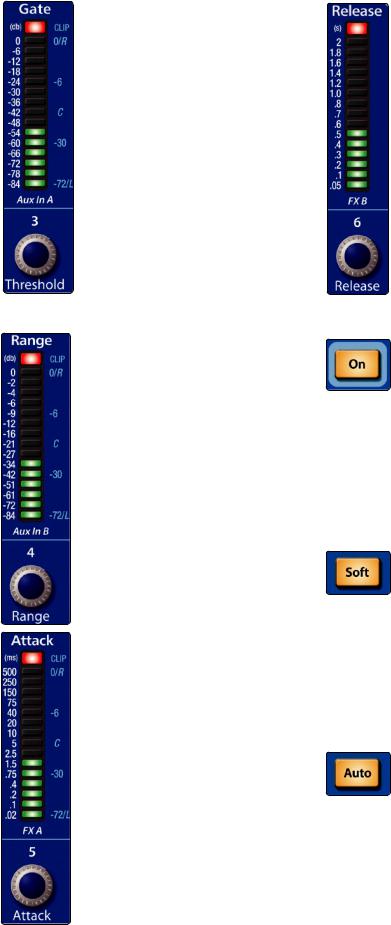
4 Controls
4.1The Fat Channel
Gate Threshold. Sets and Displays the Threshold of the Gate for the Selected Channel.
This encoder sets, and the meter displays, the gate threshold for the selected channel. The gate threshold sets the level at which the gate opens. Essentially, all signals above the threshold setting are passed through unaffected, whereas signals below the threshold setting are reduced in level by the amount set by the range control. If the threshold
is set fully counterclockwise, the gate is turned off (always
open), allowing all signals to pass through unaffected. You can set the threshold from 0 to -84 dB.
Gate Range (32.4.2AI and 24.4.2AI only). Sets and Displays the Range of the Gate.
This encoder sets, and the meter displays, the amount of gain reduction that the gate will produce. The range can be set from 0 to -84 dB.
Range control is not available when using the expander. 16.4.2AI users can access the variable Gate Range control from VSL-AI and SL Remote-AI.
Gate Attack (32.4.2AI and 24.4.2AI only). Sets and Displays the Gate Attack Setting for the Selected Channel.
This encoder sets, and the meter displays, the rate at which the gate opens on the selected channel or output. You can
set the attack time from 0.02 to 500 ms. 16.4.2AI users can access the variable attack time from VSL-AI and SL Remote-AI.
Power User Tip: A fast attack rate is crucial for percussive instruments. Slow-rising signals such as vocals and bass guitar require a slower attack; with these signals, a faster attack can cause an audible click. All gates have the ability to click when opening but a properly set gate will never click.
StudioLive™ 32.4.2AI
Owner’s Manual
Gate Release. Sets and Displays the Rate at Which the Gate Closes on the Selected Channel.
This encoder sets, and the meter displays, the rate at which the gate for the selected channel closes. The release time can be set from 0.05 to 2 seconds.
Power User Tip: Gate-release times should typically be set so that the natural decay of the instrument or vocal being gated is not affected. Shorter release times help to clean up the noise in a signal but may cause “chattering“ with percussive instruments. Longer release times usually eliminate chattering and should be set by listening carefully for the most natural release of the signal.
Compressor On/Off. Turns the Compressor On and Off for the Selected Channel or Output Bus.
This button engages or disengages the compressor for the selected channel or output bus. It will illuminate to indicate that the compressor has been enabled.
The compressor is available for all 32/24/16 input channels and every output bus.
Soft Knee Toggle Button.
Engages Soft-Knee Compression.
In normal operating mode, the compressor is set for hard-knee compression, meaning that the gain reduction applied to the signal occurs as soon as the signal exceeds the level set by the threshold. When the Soft Knee button is engaged, the ratio increases gradually as the signal reaches the threshold.
Auto Mode Button. Enables Automatic Attack and Release Mode.
When Auto mode is active, the Attack and Release controls become inoperative, and a preprogrammed attack and release curve is used. In this mode, the attack is set to 10 ms, and the release is set to 150 ms. All other compressor parameters can still be adjusted manually.
21
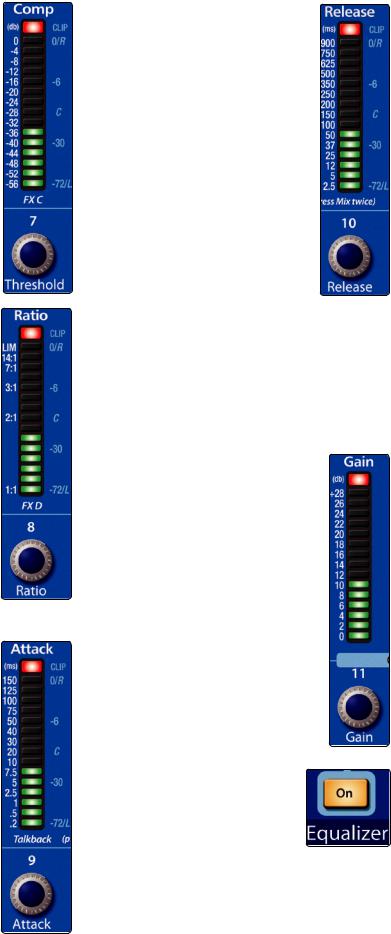
4 Controls
4.1The Fat Channel
Compressor Threshold. Sets and Displays the Threshold of the Compressor for the Selected Channel or Output Bus.
This encoder sets, and the meter displays, the compressor threshold for the selected channel or output bus. When the signal’s amplitude (level) exceeds the threshold setting,
the compressor engages. Turning the knob counterclockwise lowers the threshold so that compression begins at a lower amplitude. The threshold can
be set from -56 to 0 dB.
Ratio. Sets and Displays the Compression Ratio for the Selected Input Channel or Output Bus.
This encoder sets, and the meter displays, the compression ratio (or slope) for the selected channel or output bus. The ratio sets the compression slope, which is a function of the output level versus the input level. For example, if you have the ratio set to 2:1, any signal levels above the threshold setting will be compressed at a ratio of 2:1. This means that for every 2 dB of level increase above the threshold, the compressor’s output will only increase 1 dB. The ratio
can be set from 1:1 to 14:1.
Compressor Attack. Sets and Displays the Compressor Attack Setting for the Selected Input Channel or Output Bus.
This encoder sets, and the meter displays, the compressor’s attack setting for the selected channel or output bus. Attack sets the speed at which the compressor acts on the input signal. A slow attack time (fully clockwise) allows the beginning component of a signal (commonly referred to as the initial transient) to
pass through, uncompressed, whereas a fast attack time (fully counterclockwise) triggers compression immediately when a signal exceeds the threshold. You can set the attack from
0.2 to 150 milliseconds.
StudioLive™ 32.4.2AI
Owner’s Manual
Compressor Release. Sets and Displays the Compressor Release Setting for the Selected Input Channel or Output Bus.
This encoder sets, and the meter displays, the release setting of the compressor for the selected channel or output bus. Release sets the length of time the compressor takes to return the gain reduction back to zero (no gain reduction) after crossing below the compression threshold. Release can be set from 2.5 to 900 milliseconds.
Power User Tip: Very short release times can produce a choppy or “jittery” sound, especially when compressing instruments that have a lot of low-frequency components, such as bass guitar. Very long release times can result in an overcompressed, or “squashed,” sound. All ranges of release can be useful, however, and you should experiment to become familiar with different sonic possibilities.
Compressor Makeup Gain. Sets and Displays the Amount of Makeup Gain for the Compressor on the Selected Input Channel or Output Bus.
This encoder sets, and the meter displays, the makeup-gain setting of the compressor for the selected channel or output bus. When compressing a signal, gain reduction usually results in an overall attenuation of level. The gain control allows you to restore this loss in level and readjust the volume to the precompression level (if desired). You can adjust Makeup Gain from 0 dB (no gain adjustment) to +28 dB.
Equalizer On/Off Button (32.4.2AI and 24.4.2AI only).
Globally switches all EQ Bands On or Off for the Selected Input Channel or Output Bus.
This button engages or disengages the equalizer for the selected channel or output bus. It will illuminate to indicate that the equalizer has been enabled.
The equalizer is available for all 32/24 input channels and every output bus.
22
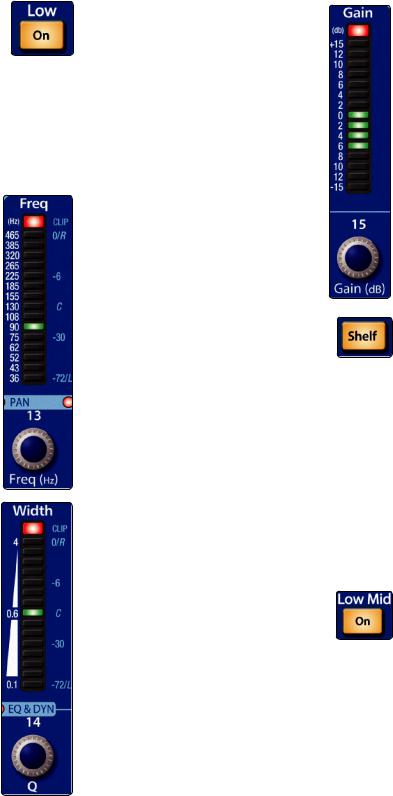
4 Controls
4.1The Fat Channel
Low EQ On/Off Button. Turns the Low Band EQ On/Off for the Selected Input or Output Bus.
This button activates the equalizer’s Low band for the selected channel or bus. The button will illuminate to indicate control is active.
The Low EQ band is available for all 32/24/16 input channels and every output bus.
Low EQ Frequency Control. Sets and Displays the Center Frequency of the Low EQ Band.
This encoder sets, and the meter displays, the center frequency of the equalizer’s Low band. The center frequency is the middle of the passband (the mean) between the lower and upper cutoff frequencies that define the limits of the band.
You can adjust the center frequency from 36 to 465 Hz.
Low EQ Q Control (32.4.2AI and 24.4.2AI only). Sets and Displays the Q of the Low Frequency Band.
This encoder sets, and the meter displays, the Q for the Low band. The Q is the ratio of the center frequency to the bandwidth. When the center frequency
is constant, the bandwidth is inversely proportional to the Q, so as you raise the Q, you narrow the bandwidth. 16.4.2AI users can access the variable Low EQ Q Control from VSL-AI and SL Remote-AI.
StudioLive™ 32.4.2AI
Owner’s Manual
Low EQ Gain Control. Sets and Displays the Gain Attenuation or Boost of the Center Frequency.
This encoder sets, and the meter displays, the gain cut or boost at the center frequency for the Low band. The level of the center frequency can be set between -15 and +15 dB.
Low Shelf EQ Button. Turns on the Low Shelving EQ for the Selected Input or Output Bus.
When the Shelf button is not engaged, the Low band is parametric. Enabling the Shelf button turns the Low band into a low-shelving EQ that alters, by a fixed amount, a band of low frequencies at and below a
user-selected shelving frequency.
Power User Tip: A low shelving EQ is like a bass-control knob on a stereo. In this mode, the Center Frequency control selects the shelving frequency.
Low-Mid EQ On/Off Button.
Turns the Low-Mid EQ On/Off for the Selected Input or Output Bus.
This button activates the equalizer’s Low-Mid band for the selected input or output. The button will illuminate to indicate control is active.
The Low-Mid EQ is available for all 32/24/16 input channels and every output bus.
23
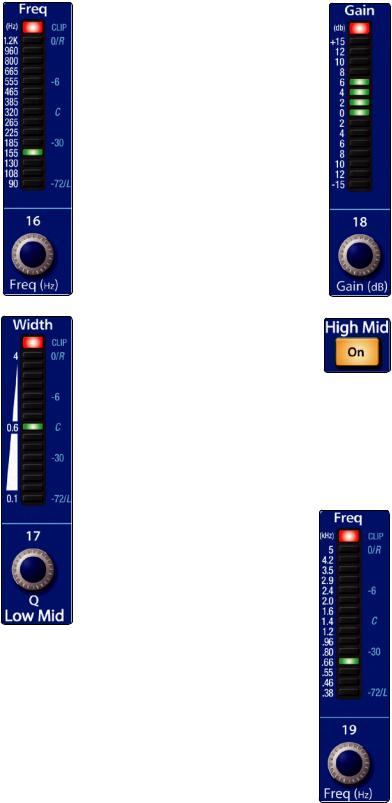
4 Controls
4.1The Fat Channel
Low-Mid EQ Frequency Control. Sets and Displays the Center Frequency of the Low-Mid EQ.
This encoder sets, and the meter displays, the center frequency for the Low-Mid band. You can adjust the center frequency from 90 Hz to 1.2 kHz.
Low-Mid EQ Q Control (32.4.2AI and 24.4.2AI only). Sets and Displays the Q of the Low Mid Frequency Band.
This encoder sets, and the meter displays, the Q for the Low-Mid band. The Q is the ratio of the center frequency to the bandwidth. When the center frequency is constant, the bandwidth is inversely proportional to the Q, so as you raise the Q, you narrow the bandwidth. 16.4.2AI users can access the variable Low-Mid EQ Q Control from VSL-AI and SL Remote-AI.
Note: While the StudioLive 16.4.2AI doesn’t have a variable Q control for any of its bands from its control surface, it does offer a Hi Q button for the Low-Mid Frequency Band. This button will narrow the Q
of the Low-Mid Band to 2.0 to provide more exact control. By default, the Low-Mid Q is set to 0.55. As previously mentioned, fully variable Q control for all bands is available from SL Remote-AI
and VSL-AI.
StudioLive™ 32.4.2AI
Owner’s Manual
Low-Mid EQ Gain Control. Sets and Displays the Gain Attenuation or Boost of the Center Frequency for the Low-Mid Band.
This encoder sets, and the meter displays, the Gain cut or boost at the center frequency of the LowMid band. The level of the center frequency can be set between -15 and +15 dB.
High-Mid EQ On/Off Button.
Turns the High-Mid EQ On/Off for the Selected Input or Output Bus.
This button activates the HighMid band for the selected input or output. The button will illuminate to indicate
that the control is active.
The High-Mid EQ is available for all 32/24/16 input channels and every output bus.
High-Mid EQ Frequency Control. Sets and Displays the Center Frequency of the HighMid EQ.
This encoder sets, and the meter displays, the center frequency of the High Mid band. You can adjust the center frequency from 380 Hz to 5 kHz.
24
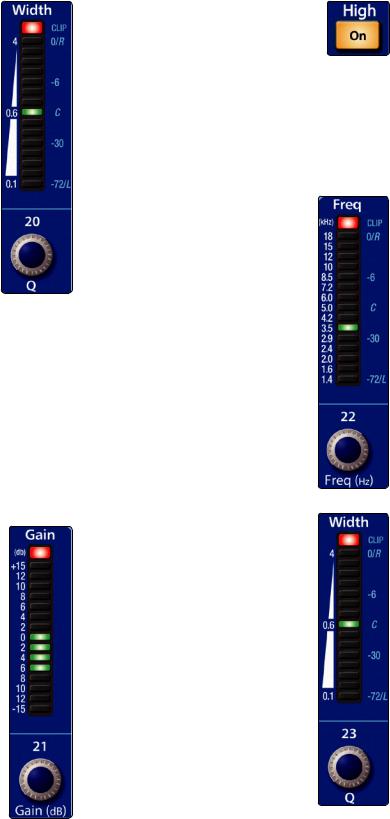
4 Controls
4.1The Fat Channel
High-Mid EQ Q Control (32.4.2AI and 24.4.2AI only).
Sets and Displays the Q of the High Mid Frequency Band.
This encoder sets, and the meter displays, the Q for the High-Mid band. The Q is the ratio of the center frequency to the bandwidth. When the center frequency is constant, the bandwidth is inversely proportional to the Q, so as you raise the Q, you narrow the bandwidth. 16.4.2AI users can
access the variable High-Mid EQ Q Control from VSL-AI and SL Remote-AI.
Please Note: While the StudioLive 16.4.2AI doesn’t have a variable Q control for any of its bands from its control surface, it does offer a Hi Q button for the High-Mid Frequency Band. This button will narrow the Q of the High-Mid Band to 2.0 to provide more exact control. By default, the High-Mid Q is set to 0.55. As previously mentioned, fully variable Q control for all bands is available from SL Remote-AI
and VSL-AI.
High-Mid EQ Gain Control. Sets and Displays the Gain Attenuation or Boost at the Center Frequency.
This encoder sets, and the meter displays, the gain cut or boost at the center frequency of the HighMid band. The level of the center frequency can be set between -15 and +15 dB.
StudioLive™ 32.4.2AI
Owner’s Manual
High EQ On/Off Button. Turns the High EQ On/Off for the Selected Input or Output Bus.
This button activates the High band for the selected channel or bus. The button will illuminate to indicate control is active.
The High EQ band is available for all 32/24/16 input channels and every output bus.
High EQ Frequency Control.
Sets and Displays the Center Frequency of the High EQ.
This encoder sets, and the meter displays, the center frequency of the High band. You can adjust the center frequency from 1.4 to 18 kHz.
High EQ Q Control (32.4.2AI and 24.4.2AI only). Sets and Displays the Q of the High Frequency Band.
This encoder sets, and the meter displays, the Q for the High band.
The Q is the ratio of the center frequency to the bandwidth. When the center frequency is constant, the bandwidth is
inversely proportional to the Q, so as you raise the Q, you narrow the bandwidth. 16.4.2AI users can access the variable High EQ Q Control from VSL-AI and SL Remote-AI.
25
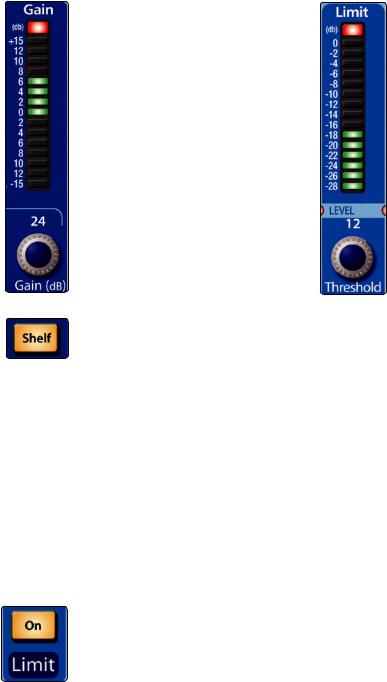
4 Controls
4.1The Fat Channel
High EQ Gain Control. Sets and Displays the Gain Attenuation or Boost at the Center Frequency of the High Frequency Band.
This encoder sets, and the meter displays, the gain cut or boost at the center frequency of the High EQ band. The level of the center frequency can be set between -15 and +15 dB.
High Shelf EQ Button. Turns on the High Shelving EQ for the Selected Input or Output Bus.
When the Shelf button is not engaged, the High band is a parametric EQ. Enabling the Shelf button turns the High band into a high shelving EQ that alters,
by a fixed amount, a band of high frequencies at and above a user-selected shelving frequency.
Power User Tip: A high shelving EQ is like a treble-control knob on a stereo. In this mode, the Center Frequency control selects the shelving frequency.
Limiter On/Off. Turns on the Limiter for the Selected Input Channel or Output Bus.
When the limiter is engaged the button will illuminate. The ratio is ∞:1.
The Limiter is available for all 32/24/16 input channels and every output bus.
StudioLive™ 32.4.2AI
Owner’s Manual
Limiter Threshold (32.4.2AI and 24.4.2AI only). Sets and Displays the Threshold of the Limiter for the Selected Channel or Output Bus.
This encoder sets, and the meter displays, the threshold of the limiter for the selected channel or output bus. When the signal’s amplitude (level) exceeds the threshold setting, the limiter
is engaged. Turning the knob counterclockwise lowers the threshold, so limiting begins at a lower amplitude. The threshold can be set from -28 to 0 dB. 16.4.2AI users can access the variable Limiter Threshold control from VSL-AI and SL Remote-AI.
26
